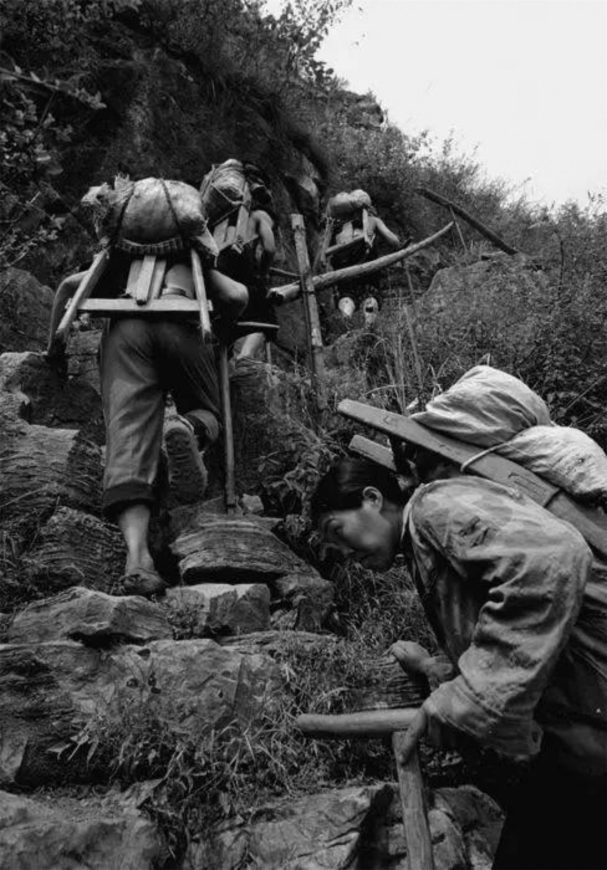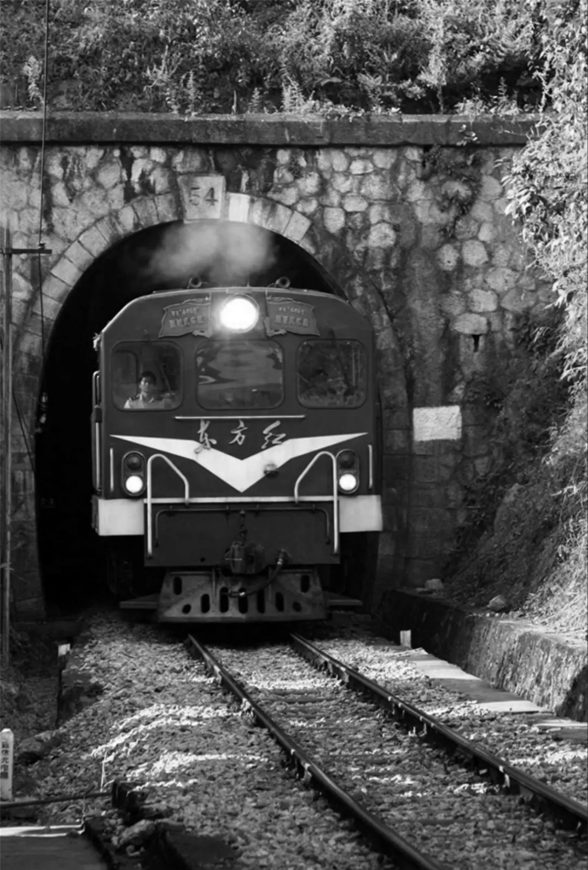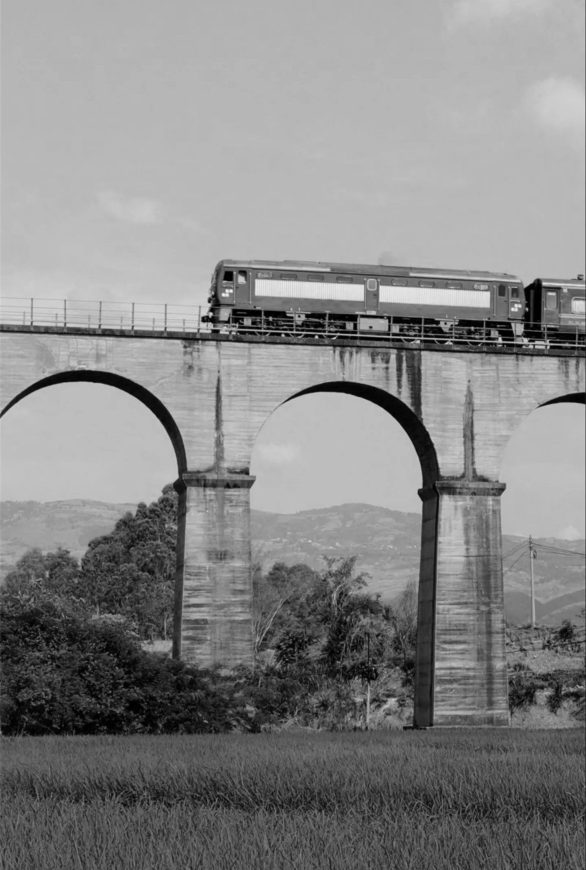本文由 因澈景观 授权mooool发表,欢迎转发,禁止以mooool编辑版本转载。
Thanks Interesting Landscape for authorizing the publication of the project on mooool, Text description provided by Interesting Landscape.
因澈景观:提到昆明,总有两条路是绕不开的,一条是兴于唐宋、盛于明清的茶马古道,另一条是二十世纪初修建的滇越铁路。
Interesting Landscape: When it comes to Kunming, there follow two roads. One is the Tea Horse Road once prospered in the Tang and Song Dynasties and peaked in the Ming and Qing Dynasties, while the other, the Yunnan-Vietnam Railway, was built in the early 20th century.
1.绕不开,在路上 A must on the road
茶马古道是指存在于中国西南地区,以马帮为主要交通工具的民间国际商贸通道,是中国西南经济文化交流的走廊。它源于古代西南边疆的“茶马互市”,代表了一个具有特定含义的历史概念。同时,茶马古道也开创了中国互补经济的先河。
The Tea Horse Road, a non-governmental international trade channel in Southwest China, with caravans as the main means of transportation, is known as a corridor for economic and cultural exchanges in Southwest China. Originated from the “Tea Horse Market” in the ancient southwest frontier, it represents a historical concept endowed with a specific meaning, and pioneered China’s complementary economy.
▽茶马古道历史背景 Historical background
而滇越铁路始建于1901年,到1910年实现了全线通车运营,全长859公里,其中滇段长度465公里,越段394公里。初建的目的是当时的法国觊觎云南丰富的矿产,后来云南解放,中国政府接管滇越铁路并进行了修复。滇越铁路不仅是一条重要的货运通道,更是抗日时期我国获取国际援助运输量最大的一条通道,对抗日战争做出了重大贡献。
正是这两条路的存在,为昆明的货运文化涂上了浓重的色彩,也为滇商的经营理念注入了强悍的活力。
The Yunnan-Vietnam Railway built in 1901 was fully opened in 1910, with a total length of 859 kilometers, of which the Yunnan section runs 465 kilometers and 394 kilometers for the overpass part. The railway was initially constructed to serve the wild ambition France for Yunnan’s rich minerals at that time. Later, the Chinese government took over the Yunnan-Vietnam Railway and repaired it as the province was liberated. The Yunnan-Vietnam Railway was not only an important freight channel, but a path that made a significant contribution to the Anti-Japanese War as it shipped the largest amount of international aid.
These two roads heavily painted Kunming’s freight culture, and injected strong vitality into the business philosophy of Yunnan merchants.
▽滇越铁路文化 Yunnan – Vietnam Railway culture
2.二次相遇 The second encounter
这次为俊发集团打造的滇忆465项目,就是围绕着这两条货运通道的线索展开的,我们将其称为“滇越铁路与茶马古道的第二次相遇”。在滇忆465项目里有两条平行的故事线,一条以小火车为代表的滇越铁路为出发点,另一条则以马帮文化为出发点进行铺陈。就像现实中一样,茶马古道和滇越铁路在路线上也会有很多交汇点,而这些地方无疑汇聚成了重要的市集,而我们打造的街区本就是市集的构成模式,这也巧妙地将我们的设计与在地文化做了有效的结合,于是历史中的元素和场景便会自然而然地流露其中。
The Dian Yi 465 project built for Junfa Group bases these two freight channels. We call it “the second encounter between the Yunnan-Vietnam Railway and the Tea Horse Road”. Two parallel story lines run through the Dian Yi 465 project, one is the Yunnan-Vietnam Railway represented by the small train, and the other is unfolded based on the caravan culture. Just like in reality, the Tea Horse Road meets the Yunnan-Vietnam Railway in various places, where undoubtedly house essential markets. The neighborhood we shaped mirrors the composition model of the market, which skillfully combines our design with the local culture, enabling us to reveal elements and scenes in the history therefrom.
▽巧妙的设计将滇越铁路与茶马古道交汇 The ingenious design connects the Yunnan-Vietnam Railway with the tea-horse ancient Road
这是一种生长型的设计方式,并没有刻意去装饰,而是让场景自己生长出来,这种方式有一个特点,那就是并非设计完成,修建完工,项目就固定了。相反,我们的设计其实只是在这块场地里撒下了一粒种子,街区在运营的过程中可以自由地生长,发展出自己的衍生品,这才是我们所说的有生命、有灵魂的街区。
This is a growth-type design method. In stead of deliberate decoration, we value the nature growth of the scene itself. A typical characteristic is that the project is yet to be fixed even though the design and the construction are completed. On the contrary, we just sowed a seed there. The block grows freely and develops its own derivatives in the process of operation. This is what we call life and a souled block.
▽实景呈现 Live-action rendering
3.记忆中的味道 Taste of memory
“寻找记忆”在滇忆465项目中是一个重要的思考方向,我们在设计之初翻阅了大量的文献资料,去研究滇越铁路和茶马古道的历史、文化以及元素符号,这于设计师而言是一场别开生面的旅行。我们在文献中看到了盘溪站的36棵巨大香樟树,见到了滇中粮仓的宜良,品尝那里的三块一拾烧豆腐。
甚至闻到了香飘街巷的宜良烤鸭。
“Looking for memory” constitutes an important thinking orientation in the Dian Yi 465 project. At the beginning of the design, we read a lot of documents to study the history, culture and element symbols of the Yunnan-Vietnam Railway and the Tea Horse Road. It’s an extraordinary journey. We saw 36 huge camphor trees at Panxi Station in the literature, met Yiliang in the granary in central Yunnan, and tasted the roasted tofu of the brand, A Good and Cheap Toufu, there.
We even smelled the Yiliang roast duck in Xiangpiao Street.
▽热闹的街巷氛围-效果图 Design renderings
我们想,这就是滇忆465要寻找的记忆中的味道,也是云南人民几百年传承下来的烟火气息。于是,这些生命文化中的元素符号,便慢慢地生长在了我们的蓝图之中。
It dawned on us that this is the taste in the memory that Dian Yi 465 is looking for, and also the hustle and bustle passed down by the people of Yunnan for hundreds of years. Then these symbols walking in histories gradually appeared in our blueprint.
▽热闹的街巷氛围-效果图 Design renderings
4.时代共情 Empathy of the Times
当然,我们并没有忘记,滇忆465是一个溯源于螺蛳湾国际商贸城的当代网红外挂街区,在寻找并展现文化记忆的同时,需要被人们记住的还有当下。特色之余,体验感和网红效应也应该成为街区重点关注的设计要点。毕竟,为街区注入活力最主要的载体还是我们当代人。所以,下一步工作就是将收集到的文化符号转置为当代人更容易读取的艺术语言。拿来主义只是生活不是艺术,就像杜尚的小便池,只有放在美术馆的展台上才能成为承载历史和思想的艺术品。而我们要做的就是为文化符号建立属于它自己的展台,供游客打卡、拍照、欣赏。
于是,被赋予文化特色的多个艺术网红景观应运而生,也成为了作为景观设计师的我们跨界完成的艺术作品。
Meanwhile, not a second have we forgotten that Dianyi 465 is a contemporary online sensation block that traces its origins from Luosiwan International Trade City. While looking for and displaying cultural memory, the present is also worth to be remembered. In addition to the characteristics, the sense of experience and the internet hit effect should also be included in the design points. After all, we, the moderns, largely inject vitality into the neighborhood. Therefore, the next step is to transpose the collected cultural symbols into an artistic language that is easier to read by contemporary people. Copinism is just life, not art. Just like Duchamp’s urinal is a work of art that carries history and ideas only when it is placed on the exhibition stand of an art museum. Our job is to build its own booth for cultural symbols for tourists to visit, take photos and enjoy.
Whereupon, a number of artistic network hit landscapes endowed with cultural characteristics rise in response to the proper time and conditions that become cross-border works of art completed by us as landscape architects.
a.记忆滇越 Memory of Yunnan and Vietnam
推开记忆的大门,让我们追寻,先辈们开拓的足迹。景观分别提取官渡区历史文化及滇越铁路传承脉络,打造景观入口大门。意在打造历史文化氛围,传递地缘文化知识,增强游客身份认同感。
Open the door of memory, let us follow the footsteps of our ancestors. The landscape extracted from the history and culture of Guandu District and the heritage of the Yunnan-Vietnam Railway shapes an entrance gate. It is intended to create a historical and cultural atmosphere, popularize geocultural knowledge, and enhance tourists’ sense of identity.
▽记忆的入口大门-效果图 Memory of the entrance gate renderings
▽记忆的入口大门-实景图 Memory of the entrance gate real scene
b.时光号 Time
“螺蛳湾”是一辆时光列车,带我们一起走进历史,了解过去。滇越铁路是中国西南地区第一条铁路,为米轨铁路,于1910年4月1日全线通车运营。承运的近百年,见证了云南乃至全中国的沧桑巨变,承载着无数的滇越故事、铁路故事。设计使用曾在滇越铁路上运营的KD55型蒸汽机车造型,结合项目案名,打造专属于本项目的网红打卡点。在吸引视线的同时起到引导人流的作用。
“Luosiwan” is a train of time that takes us into history and to understand the past. The Yunnan-Vietnam Railway, the first railway in Southwest China, is a meter-gauge railway and was fully opened on April 1, 1910. Over the nearly 100 years of service, it has witnessed the vicissitudes of life in Yunnan and even the whole of China, carries countless stories of Yunnan and Vietnam and railways. The design refers to the shape of the KD55 steam locomotive that used to run on the Yunnan-Vietnam Railway, thereby giving birth to a hit tick-off scenic area exclusively for this project combining with the project name. It is expected to guide the flow of visitors while attracting attention.
▽时光号列车打卡点-效果图 The time train clocks in
▽时光号列车打卡点-实景图 The time train clocks in
c.带上你的故事跟我走 take your story and come with me
沿着昆明站前广场,带上你我的故事,开启这段旅程。在人行天桥上下扶梯处,根据铁路车厢形态打造特色小吃摊,结合铁路站台设置外摆空间,吸引游客进入项目场地。
Along the square in front of Kunming Railway Station, let us start this journey with stories. At the upper and lower escalators of the pedestrian bridge, special food stalls are built according to the shape of the railway carriages, and the outside space is set up in combination with the railway platform to intrigue tourists.
▽站前广场节点-效果图 Station front square node
▽站前广场节点-实景图 Station front square node
d.记忆中的“它们” “Them” in memory
滇越铁路开通百余年,米轨承载着记忆,现在我们把记忆呈现给大家去追寻。选取曾在滇越铁路运营,如今陈列于云南铁路博物馆的三款车型——KD55、米其林蒸汽机车、东方红21,结合地库出入口的背侧打造成为滇越铁路的机车仓库。提供给游客拍照打卡或停留休息。
Over the more than 100-year service of the Yunnan-Vietnam Railway, the meter gauge carries are filled with memories. Now let’s present and travel back to the memory. Three models, KD55, Michelin steam locomotive, and Dongfanghong 21, which once ran on the Yunnan-Vietnam Railway and are now displayed in the Yunnan Railway Museum, were selected and built into the locomotive warehouse of the Yunnan-Vietnam Railway in combination with the back of the basement entrance and exit, providing tourists with a tick-off site or check in or a stop to rest.
▽机车仓库节点-效果图 Locomotive depot section
▽机车仓库节点-实景图 Locomotive depot section
e.时光印记 Time stamp
老螺蛳湾是繁华的街市,新螺蛳湾继承了繁华,更发展了新业态、迸发了新活力。在项目临近广场一侧出入口,结合项目特色与历史文脉,打造具有引导性的立体字景观。
The past Luosiwan was a bustling market. While it now inherits the prosperity, and develops new formats and bursts of new vitality. At the entrance and exit of the project near the square stands a guiding three-dimensional character landscape created combining with the project characteristics and historical context.
▽广场一侧出入口-效果图 Square side entrance and exit
▽广场一侧出入口-实景图 Square side entrance and exit
f.瞅你咋地 Look at you (Chou Ni Za Di)
作为文化符号的马,改变了材质肌理被赋予了新姿态,引领着潮流。设计师将代表着茶马古道文化的 “马”打造成为商店节点的景观雕塑,使用较为现代的玻璃钢材质,赋予传统文化符号潮流特质。
As a cultural symbol, the horse with a new texture is given a new attitude, leading the trend. The designer turned the “horse” representing the ancient Tea Horse Road culture into a landscape sculpture. Relatively modern fiberglass materials endow the traditional cultural symbol with the trendy features.
▽马文化的景观元素-效果图 Landscape elements of horse culture
▽马文化的景观元素-实景图 Landscape elements of horse culture
g.时光重影、门庭若市 Time shadows, bustling visitors
步入山涧峡谷,穿越重重隧道,来到繁华市井。在商业建筑的空隙处,设计一组门型雕塑,将滇越铁路的文化融入其中,让游客在感受文化氛围的同时,了解到那一段历史。
Stepping into the mountain canyon and passing through numerous tunnels, there reveals a bustling market. In the space of commercial buildings, a group of door-shaped sculptures is designed to integrate the culture of the Yunnan-Vietnam Railway, allowing tourists to learn about the history while experiencing the cultural atmosphere.
▽时空隧道-效果图 Time and space tunnel
▽时空隧道-实景图 Time and space tunnel
h.街坊四邻 Neighbourhood
街坊四邻是游子归家的灯塔,家乡熟悉品牌,唤起最深的乡土记忆。在宜良站设计一座灯塔,将螺蛳湾与云南本土品牌植入其中,起到昭示性作用的同时对云南本土文化进行宣传。
Neighbourhood charts course for wanderers to return home. Familiar hometown brands evoke local memories kept inside. A lighthouse designed at Yiliang Station covers Luosiwan and Yunnan local brands, which becomes a symbol and advertises local culture.
▽昭示性灯塔-效果图 A beacon
▽昭示性灯塔-实景图 A beacon
i.忘忧杂货铺 Worry-free grocery store
回忆小时候,村口奶奶的零售铺,是我们的快乐天地。设计师将童年记忆带入到景观设计之中。在复原滇越铁路沿线传统建筑的同时,将传统物件带入其中,打造出童年时期最难忘的一方天地。
Grocery stores opened by grandmas at the entrance to the village are part of beautiful memories of childhood. The designer displays childhood memories through the landscape design. While restoring the traditional buildings along the Yunnan-Vietnam Railway, traditional objects were brought into it to create the most unforgettable place in childhood.
▽记忆中的杂货铺-效果图 A grocery store in memory
▽记忆中的杂货铺-实景图 A grocery store in memory
j.66路公交站 66 bus stop
66路公交是宜良的环线,一圈又一圈地环绕着宜良,带来宜良的烟火气。景观设计结合宜良66路环线公交车打造一座复古站台,为游客提供一个休息与找寻从前旧时光的场景。
Bus No. 66, a ring line of Yiliang, surrounds Yiliang one after another, activating the city. The landscape design is combined with the bus line to create a retro platform that provides a scene for tourists to rest and find the old times.
▽公交元素演绎的休闲空间-效果图 Leisure space interpreted by bus elements
▽公交元素演绎的休闲空间-实景图 Leisure space interpreted by bus elements
k.走入马帮 Into the caravan
马的嘶叫和嗒嗒的马蹄,马铃的声音,人的脚步,就是茶马古道这个独特世界里最主要的产物。以立体剪影的方式将设计师手绘的茶马古道场景结合实体雕塑制作成为独具特色的艺术景墙。
The neighing of horses, the clattering of hooves, the sound of horse bells, and the footsteps of people constitute the most important products in the unique world of the Tea Horse Road. In the form of three-dimensional silhouettes, the designer’s hand-painted tea horse road scenes are combined with physical sculptures to make a unique artistic wall.
▽立体剪影的茶马古道艺术景墙-效果图 Three-dimensional silhouette of the art landscape wall of tea horse Ancient Road
▽立体剪影的茶马古道艺术景墙-实景图 Three-dimensional silhouette of the art landscape wall of tea horse Ancient Road
l.旧时古道、马铃摇曳 Ancient roads, horse bells swaying
回到旧时的茶马古道,伴着阵阵马铃,骡马渐次步入我们的视野。在盘溪站前,提取马帮元素,运用圆雕、镂雕等手法,将茶马古道上重要的交通工具——骡马呈现在人们面前,带大家体验茶马古道的文化。
Back to the old tea-horse road, mules and horses gradually entered our field of vision in the accompany of bells. In front of Panxi Station, elements of the caravan extracted to present the mule and horse, an essential means of transportation on the Tea Horse Road, in front of visitors, in virtue of round and engraved carving, enabling them to experience the culture of the Tea Horse Road.
▽马帮文化雕塑-效果图 Horse gang culture sculpture
▽马帮文化雕塑-实景图 Horse gang culture sculpture
m.老李的轧道车 Old Li’s track car
盘溪站旁有一座巡检铁路的岗亭,老李在这里,奉献了他的青春。铁路巡检员是极为辛苦的职业,每天从巡检站出发,循着铁路步行检查铁路的安全状况,在每一寸铁轨上都留下了他们的足迹。我们便将巡检工人们休息存放工具的岗亭复原放置于景观节点当中,让人们去了解到这一不为人所熟悉的职业。
A post for patrolling the railway lies next to Panxi Station, where Lao Li dedicated his youth. Railway inspectors are extremely hard-working. They start from the inspection station every day, walk along the railway to check the safety of the railway, and leave their footprints on every inch of the railway track. We restored the posts where the inspection workers rested and stored tools and placed them in the landscape nodes, so that people could learn about this occupation.
▽节点场景的演绎-效果图 The deduction of node scenes
▽节点场景的演绎-实景图 The deduction of node scenes
n.旧时脊梁 The old back
盘溪,背夫弯曲的脊梁,背出了茶马古道的繁华。茶马古道异常凶险,有些地段连马驮运货都无法通行,就得由人力运输,于是就产生了“背夫”这个特殊职业,这些平凡的背夫,用生命铺就了这条逶迤于滇越线之上的千年古道。设计师将背夫这一形象,结合商业元素,打造成为专属于茶马古道的自动贩卖机形象。
Panxi, the back of the man’s curved spine, bears the prosperity of the Tea Horse Road. The extremely dangerous path even stopped horses in some areas, triggering a special occupation of “porter”. These ordinary porters spent their lives to pave this thousand-year-old ancient road on the Yunnan-Vietnam line. The designer combined the image of porter with commercial elements to create an image of a vending machine exclusive to the Tea Horse Road.
▽文化元素与商业化的融合-效果图 The fusion of cultural elements and commercialization
▽文化元素与商业化的融合-实景图 The fusion of cultural elements and commercialization
o.白驹过隙、时间剪影 Time flies,silhouette
即将离开盘溪,马帮工人们也牵着骡马,逐渐向远方走去。在离开盘溪站的一侧,结合茶马古道中牵马工人的形象,设计一面剪影墙,将游客逐渐引向之后的旅程。
About to leave Panxi, the caravan workers led the mules and horses walking into the distance. On the side of leaving Panxi Station, a silhouette wall is designed in combination with the image of the horse-drawing workers on the Tea Horse Road, which gradually guides tourists to the next journey.
▽牵马工人剪影墙-效果图 Silhouetted wall of men leading horses
▽牵马工人剪影墙-实景图 Silhouetted wall of men leading horses
p.思乡者 Homesicker
旅途到了终点坐下休息,回味故乡的点点滴滴,品味滇越铁路和茶马古道的别样风情。盘溪站外,设计师将马的形象与休憩座椅巧妙结合,打造出提供给游客停留休息的特色座椅。
At the end of the journey, sit down and rest, reminisce about the bits and pieces of the hometown, and taste the diverse customs of the Yunnan-Vietnam Railway and the Ancient Tea-Horse Road. Outside the Panxi Station, the designer skillfully combined the image of a horse with the rest seats to create a special seat for tourists to stop and rest.
▽马元素景观座椅-效果图 Horse element landscape seating
▽马元素景观座椅-实景图 Horse element landscape seating
q.追忆站台 Remembrance platform
老站台、广告牌,这些上世纪的产物,和滇越铁路一样在逐渐离我们远去。但每每看到,都会唤醒我们的回忆。在最后一个多经点位的设计中,设计师采用了回顾的手法,设计了一个复古站台形象,给予游客一个停留的空间,让他们能够在这片刻的驻足中回忆景观带来的种种映像。
Like the Yunnan-Vietnam Railway, the old platforms and billboards, the products of the last century, are gradually drifting away from us. But every time we see it, it awakens our memories. In the design of the last multi-passage point, the designer retrospectively designed a retro platform image, giving tourists a space to stay, so that they can recall the images brought by the landscape in this momentary stop.
▽延续记忆中的老站台-效果图 Continuation of the memory of the old platform
▽延续记忆中的老站台-实景图 Continuation of the memory of the old platform
5.使徒行者 The Apostles
作为设计师,总该有些使命感在身上,我们不像纯粹的艺术家,我们的作品动辄上万平米,每天经过、体验、使用的人流数不胜数,如果在人们生活的使用功能之外,还能唤起一些记忆的碎片,或者发现一些艺术的品位,我认为就足够了。
作为使徒,我们在打造滇忆465项目时追寻的是什么?
我想:“食一碗烟火,耀世繁华!”足以概括
A designer always carries some sense of mission. Different from pure artists, our works are tens of thousands of square meters. Countless people pass through, experience and use them every day. A few fragments of memory, or a taste for discovering some art, I think will suffice, in addition to serving people’s life.
As apostles, what did we pursue when we created the Dianyi 465 project?
“Biting a hustle and bustle is all”, for me.
项目名称:滇忆465
项目地点:云南省昆明市官渡区彩云北路5151号俊发新螺蛳湾国际商贸城
项目规模:一期设计面积68019.3㎡
项目类型:旧改
委托单位:俊发集团有限公司
甲方设计团队:衣佰文、翟娅琴、张飞
设计单位:成都因澈思明景观设计有限公司
景观施工单位:云南和润景观
建成时间:2021年12月
摄影团队:镜上摄影
Project: Dian Yi 465
Location: luosiwan International Trade City, No. 5151, Caiyun North Road, Guandu District, Kunming City, Yunnan Province
Scale: The design area of the first phase is 68,019.3㎡
Type: Renovation
Client: Junfa Group Co., Ltd.
Party A’s design team: Yi Baiwen, Zhai Yaqin, Zhang Fei
Design unit: Chengdu Interesting Landscape Design Co., Ltd.
Landscape construction unit: Yunnan Herun Landscape
Completion time: December 2021
Photography Team: Mirror Photography
“ 通过设计将古老的历史文化延续,并演绎于我们的生活中,场景的融入去找寻过往的记忆。”
审稿编辑: Maggie
更多 Read more about:Interesting因澈景观
























































图出的还原度很高了